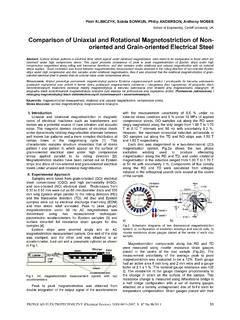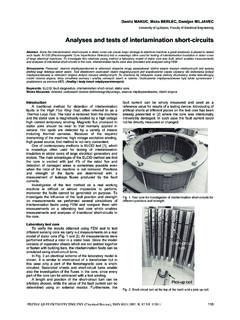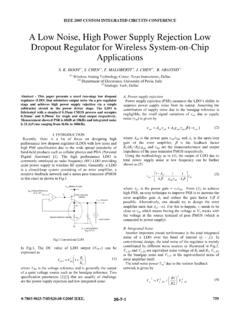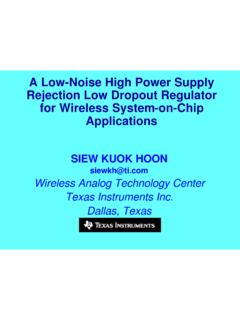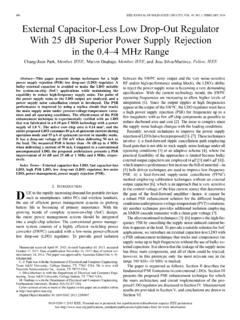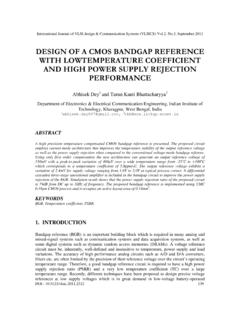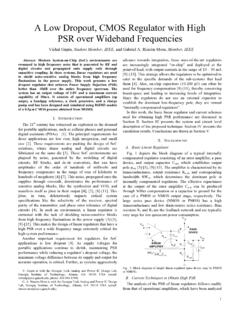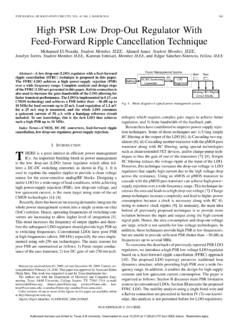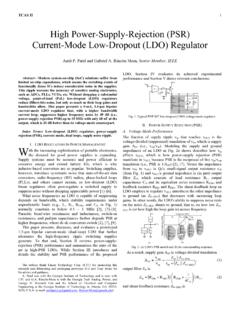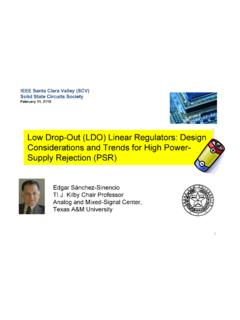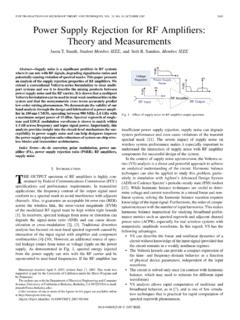Transcription of Evolution of Low Drop Out Voltage Regulator in CMOS ...
1 26 PRZEGL D ELEKTROTECHNICZNY, ISSN 0033-2097, R. 91 NR 12/2015 Norhaida Binti Mustafa, Md. Syedul Amin, Mamun Bin Ibne Reaz, Fazida Hanim Hashim, Noorfazila Kamal Universiti Kebangsaan Malaysia Evolution of Low Drop Out Voltage Regulator in CMOS Technologies Abstract. The demand for low Voltage devices has initiated the development of Low Drop Out (LDO) Regulator in manifold. This paper presents a review of various LDO frameworks that have been implemented in CMOS technologies and the impact of frameworks related to the parameters of the LDO.
2 The LDO architecture is evaluated through its power supply rejection (PSR) and transient response performance. The transient response performance mostly depends on the added buffer and the PSR performance depends on the pass device capacitance and the LDO loop gain. \ Streszczenie. W artykule przedstawiono przegl d rozwi za uk ad w LDO (Low Drop Pout) w technologii CMOS. Przedstawiono tak e rozwi zania typu PSR power supply rejection . Analizowano dynamik tych uk ad w. Tendencje rozwojowe uk ad w LDO (Low Drop Out) w technologii CMOS Keywords: CMOS, Low Drop Out (LDO) Regulator , power supply rejection (PSR), transient response.
3 S owa kluczowe: uk ady LDO Low Drop Out, technologia CMOS. Introduction power supply is one of the most vital modules in any electronic devices such as smart phones, tablet PCs, camera, MP3 player, Personal Data Assistant (PDA), Radio Frequency Identification (RFID) etc. [1-3]. Due to the rapid increasing demand for portable devices the use of efficient power management systems to prolong battery life cycle and operating time for device is becoming the most important factor [4-9]. A linear Regulator is a popular power supply which is an inductor-less, ripple-less and low-noise power converter with a bulk line frequency transformer [10].
4 In the 1970s, the linear regulators have been implemented in BJT technology and are referred as the 20 kHz revolution [7, 10]. However, the power efficiency was not sufficient for low- power operations as the ground current was load-current dependent and the dropout Voltage was large [11]. In the 1980s, the power MOSFET appeared as the dominant power device due to its high-switching frequency operation (above 100 kHz), easier driving requirement and higher reliability [10].
5 With the rapid development of CMOS technology, many variations of CMOS Voltage regulators have appeared [12-13]. There are several types of Voltage regulators such as LDO linear Regulator , Switch-Inductor Regulator (switching Regulator ) and Switch-Capacitor Regulator (charge pump) [4]. CMOS linear regulators can be categorized as low supply current, large current, high Voltage , high-speed and Low Drop Out (LDO). The device that uses a low drop-out Voltage Regulator can provide a stable output Voltage with good noise performance and less power consumption compared to switching regulators to drive small sub-circuit [5-6].
6 LDOs can operate at a low supply Voltage , which is suitable for single-cell and two-cell battery applications as the ground current LDO is load-current independent [11]. In practical applications, such as portable devices, the conventional power management system consists of Switching power Converter (SWPC) to boost up the Voltage cascaded with LDOs in series to suppress the inherent noise associated with switchers and control logic [5, 14-15]. By turning the Regulator s outputs on and off or by varying the output Voltage levels to optimize the power consumption of the device, the control logic can change the elements of each subsystem as active mode, standby mode and sleep mode [5].
7 This paper discusses the Evolution of LDO Voltage Regulator based on CMOS technology and the various properties of existing Regulator topologies with their advantages. First the architecture, principle and specification of LDO are discussed and then the description of circuit, transient response and power supply rejection characteristics of the LDO Voltage Regulator are portrayed. Finally the discussion of all the framework are presented. Architecture and principle of LDO The drop out Voltage is the bare minimum differential Voltage between the output and input Voltage at such a point where the circuit stops to regulate.
8 Also, low-dropout Voltage indicates that the Voltage across pass device is as low as 100mV to [4]. For LDO Regulator , the output Voltage is always lower than input Voltage by a minimum value of dropout Voltage . The performance is enhanced as it has low output impedance. The LDO can be applied to high power , low power and ultra-low power applications. LDO Linear Regulator Architecture Basic LDO Regulator topology usually consists of a pass device of PMOS, a decoupled capacitor CL with a parasitic resistor Resr, two feedback resistors R1 and R2, reference Voltage and a critical error amplifier as shown in Figure 1.
9 There are mainly three poles. p1 is from the output node, p2 is from the gate of the pass device and p3 is the internal pole within the error amplifier [16]. The basic schematic of generic LDO Voltage regulators is based on a PMOS. The PMOS FET with common source connection works as the pass transistor between the input and output voltages. A part of the output Voltage is fed back through R1 and R2 to the input and is compared to the Voltage reference VREF. Capacitor CL stands for the capacitive load [17]. Fig. 1.
10 Basic Low Dropout Regulator Topology [5] The operating principle of LDO is based on the output of the Regulator . It generates an error signal through the PRZEGL D ELEKTROTECHNICZNY, ISSN 0033-2097, R. 91 NR 12/2015 27 feedback network to control the output current flow through the pass transistor. The output Voltage is set to a constant Voltage level by R1, R2 and reference Voltage [5]. The divided Voltage feedback through R1 and R2 and reference Voltage difference, force the error amplifier to adjust the current flow through PMOS when changes happen at output Voltage .
